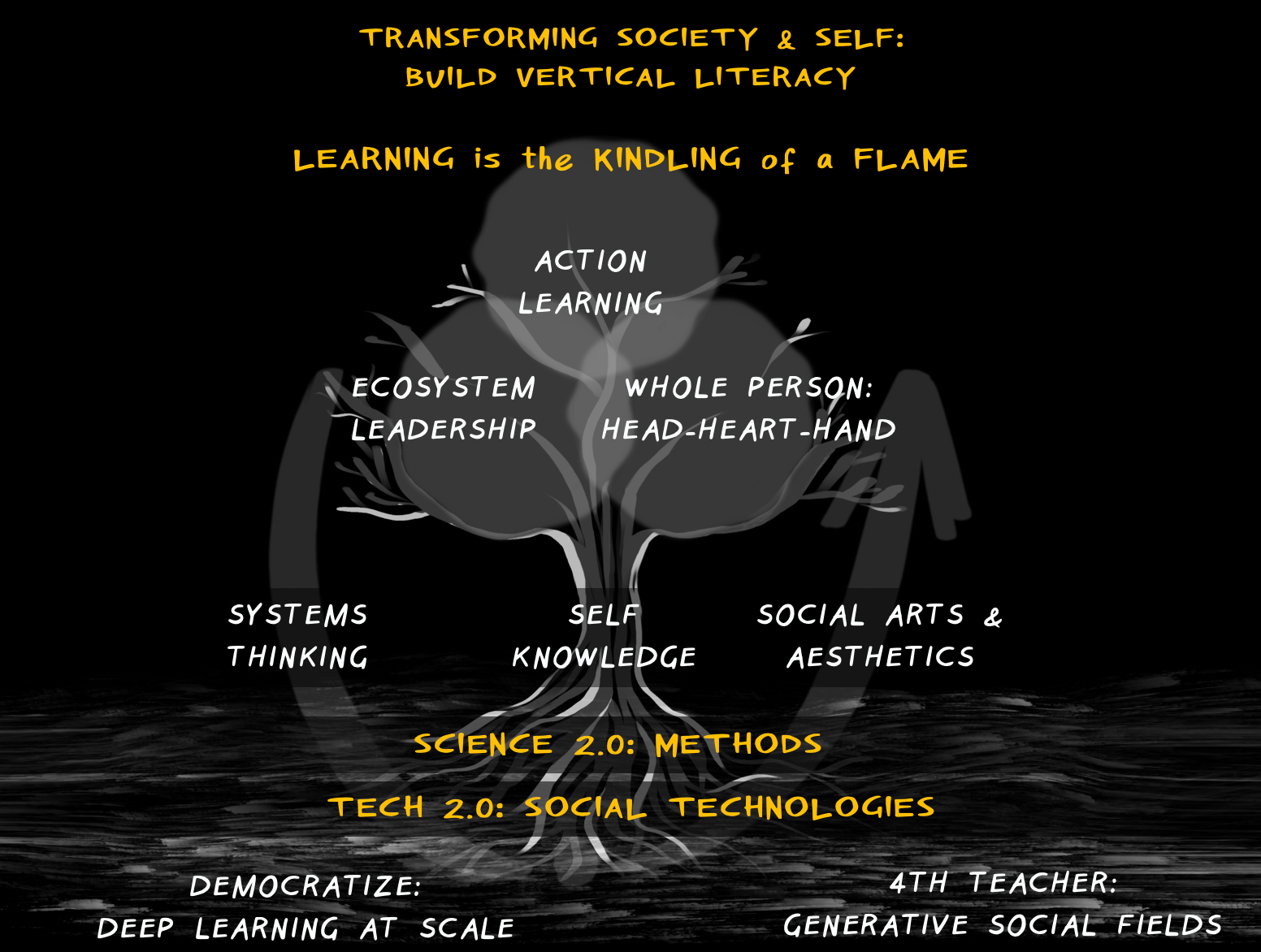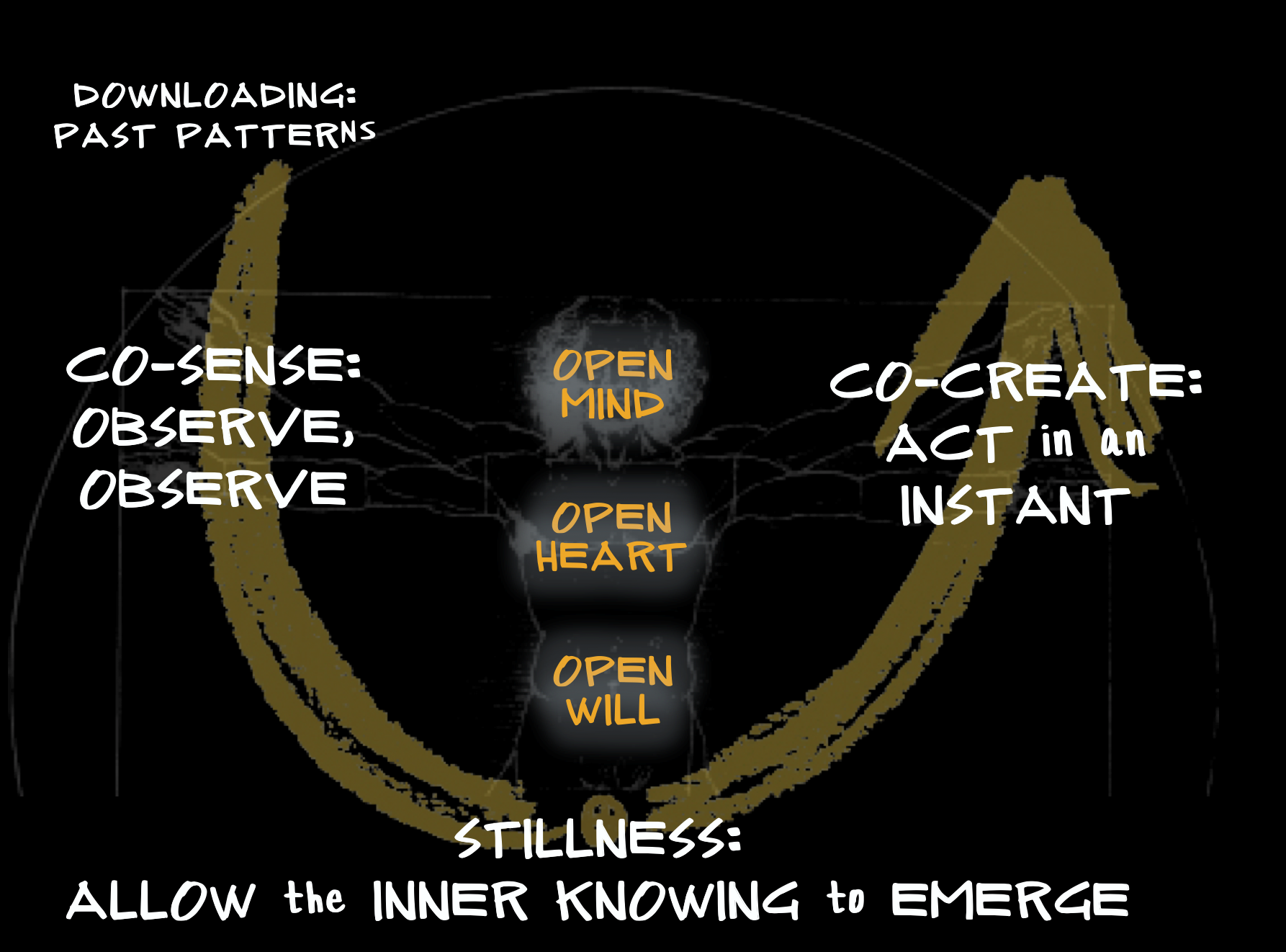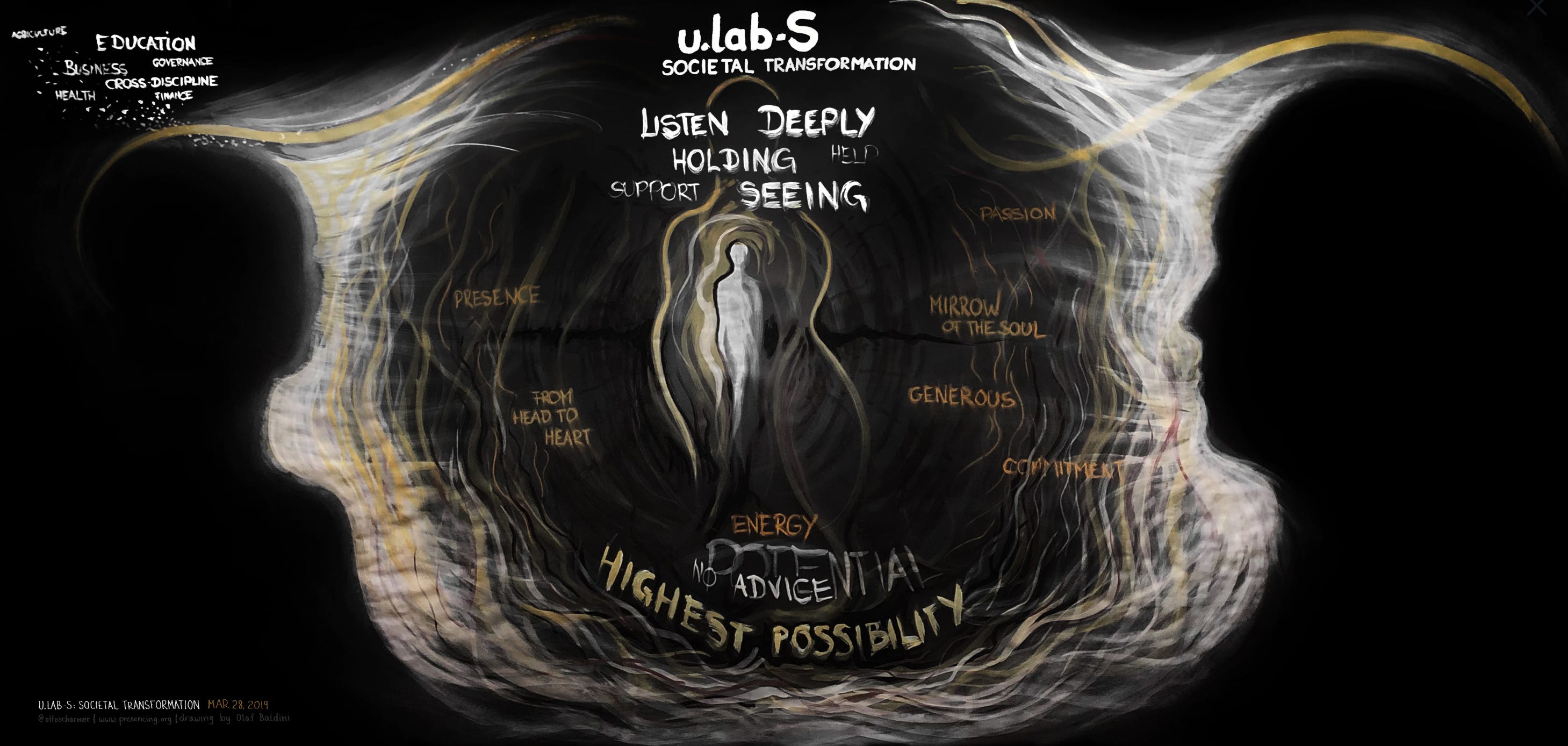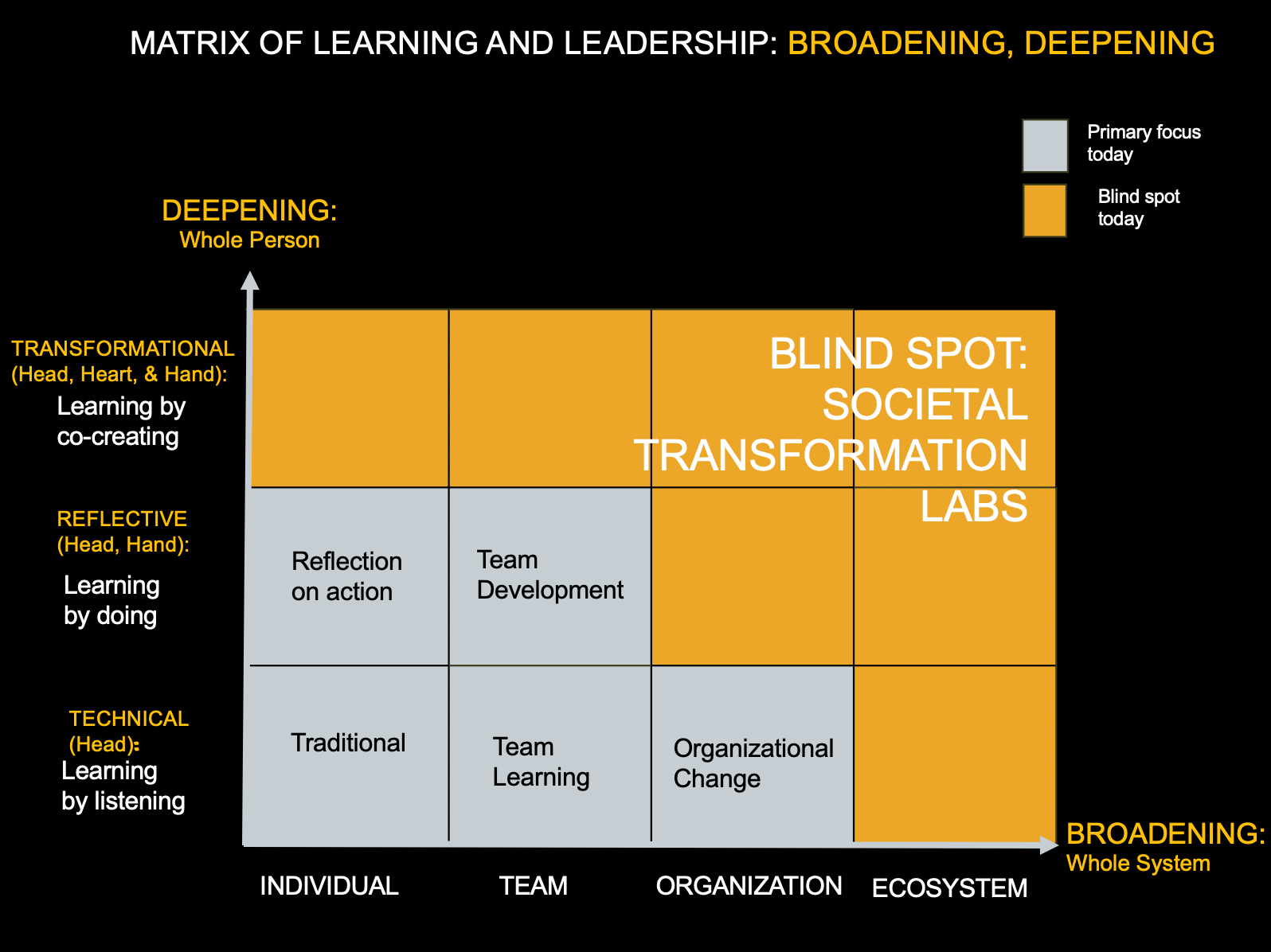Vertical Literacy: Reimagining the 21st-Century University
The Fridays For Future (FFF) climate strike by high school students may well be one of the most important, yet hardly covered stories by the US media today. During the week of March 15th alone, 1.6 million strikers were counted across 125 countries. This environmental movement to reduce carbon emissions was started by Swedish teenager Greta Thunberg in late 2018. In the meantime, a discussion has ensued among politicians in Germany about whether it is the right thing for students to take to the streets instead of the classroom on Fridays.
The principles below weigh in on this conversation from a bigger picture view: how to “update” the world’s educational system, particularly the university, to tackle the technological, environmental, and social disruptions of the 21st century. See figure 1.
 Figure 1: Twelve Principles for Reinventing the 21st Century University (and Education)
Figure 1: Twelve Principles for Reinventing the 21st Century University (and Education)
The classical university was based on the unity of research and teaching; the modern university has been based on the unity of research, teaching, and practical application. I believe that the current historical moment, with one civilization ending and dying, and another being born, invites us to reconceive the 21st-century university as a unity of research, teaching, and the praxis of transforming society and self.
Yet, the current contribution of universities to societal transformation remains unclear. This is because the traditional output of universities — knowledge — is not the missing piece to catalyzing social change. Let’s consider the example of the Paris Agreement and the 17 Sustainable Development Goals (SDGs), the current global framework outlining the transformation objectives of the next decade.
The difficulties in implementing the Paris Agreement and the SDGs worldwide are not caused by a knowledge gap. The problem is lack of political will and a knowing-doing gap: a disconnect between our collective consciousness and our collective action. This gap leads us to collectively create results that nobody wants: massive environmental destruction, societies breaking apart, and social media-induced mass separation from our deeper sources of self.
To address these profound challenges, we need new platforms and new capacities that upgrade our mental and social operating system from ego-system awareness to eco-system awareness.
Figure 2 maps the evolution of key societal systems in terms of their OS (operating system):
from 1.0 (input and authority-centric) and 2.0 (output and efficiency centric)
to 3.0 (user-centric) and 4.0 (ecosystem-centric).
 Figure 2: Four Types of OS, Four Stages of Systems Evolution (Source: O. Scharmer, The Essentials of Theory
Figure 2: Four Types of OS, Four Stages of Systems Evolution (Source: O. Scharmer, The Essentials of Theory
Since I have presented this matrix in other places, here I will focus on its essence: the vertical dimension of the matrix maps the evolution of various societal systems in terms of their operating system (OS), including the evolution of the economy to post-capitalistic ways of operating. Each later stage includes the modes of the earlier stages, but in a new meta context. It also highlights how the collective knowing-doing gap persists because we try to solve level 4 problems with OS 1.0, 2.0, or 3.0. But, as we learned from Einstein, you cannot solve problems at the same level of thinking that created them.
The main problems in our universities and schools today is the lack of vertical literacy. Vertical literacy is the capacity to lead transformative change, i.e., to shift the level of operating from 1.0 and 2.0 to 3.0 and 4.0 as needed by:
seeing yourself — i.e. self-awareness — both individually and collectively
accessing your curiosity, compassion, and courage
deepening the space for listening and conversation
reshaping the type of organizing from centralized to ecosystem
cultivating governance mechanisms that operate from seeing the whole
holding the space for profound transformation: letting go and letting come
This shift of focus is mirrored by the principal challenges we face across societal sectors, where we are often stuck in levels 1, 2, and 3 ways of operating, unable to progress to level 4. When you ask experienced CEOs and CPOs (chief people officers) of major companies, or public sector leaders, what they are trying to do and what they need, they typically say they need people who are agile and co-creative and who can make their organizations thrive in a world of volatility, uncertainty, complexity, and ambiguity. To restate that in terms of the matrix: they need capacities that can take their organizations to 4.0 ways of operating. When you talk to NGOs and civil society activists that try to change the economic system towards well-being for all, they basically say the same thing: we need to increase our capacity to collaborate and co-create across institutional and sector boundaries.
Then ask university leaders and deans of management and engineering schools the same question. There are some exceptions, but most are rather illiterate or uninformed when it comes to building the capacity for vertical development. They, like most of their faculty, live and operate most of their time in the straightforward 2.0 world of education (figure 2). Their thinking is framed in terms of horizontal development — for example, adding another skill here or another course there — not in terms of vertical development, which essentially deals with the evolution of consciousness. To use the analogy of the smartphone: they think in terms of adding another app, not in terms of upgrading the entire operating system.
In short, vertical literacy is about leading transformation by shifting consciousness from ego-system awareness to eco-system awareness. I believe that in this century the primary reason for universities to exist increasingly lies in helping individuals, organizations, and societal systems to build such vertical transformation literacy.
The following 12 principles summarize what a 21st-century university could look like if we upgraded the entire OS towards vertical literacy. The principles are not just a compilation of ideas. They are derived from two decades of hands-on experimentation and from participating in a global movement of learners and educators that is taking shape as we speak. It’s a movement focused on reinventing universities and schools as platforms for helping people and their organizations transform themselves and make the world a better place — by pioneering solutions that bridge the three major divides of our age: the ecological, the social, and the spiritual divide.
1. Transforming Society & Self: build vertical literacy
If the 21st-century university is about the unity of research, teaching and transforming society and self, learners must go out into the real world and engage with the core challenges of our time. To be relevant for society, universities need to be relevant to the pressing challenges at hand, such as the implementation of SDG goals. One of the biggest roadblocks in making progress on these challenges is the gap between knowing and doing. Addressing that gap requires a vertical literacy for leading transformational change by shifting the awareness from ego to eco (consciousness-based systems change). These deep learning capacities need to be cultivated across all levels: at the level of individuals (holding the space for self-awareness), groups (deep listening and dialogue), organizations (from centralized to ecosystems), and the evolution of larger systems (coordinating through seeing the whole). All these dimensions are at play whenever you deal with transformational change in society.
2. Kindling: learning is the kindling of a flame
“Education is the kindling of a flame, not the filling of a vessel.” Those words of Plutarch are as true today as they were two thousand years ago. Still, the misconception of education as a vessel-filling activity remains. So, if the kindling of the flame is the ultimate core of all profound learning, why do we tend to leave it to chance in institutions of education? How do we create the conditions for this to happen more intentionally? Here are three gateways to helping learners discover their own journey in life and work.
The flame can be ignited whenever you meet an inventor, entrepreneur, or change-maker who operates from his or her highest purpose and self. You meet these people, and being in their presence changes something within you. It’s subtle, but very real. It activates a spark.
Simply get out of your own bubble — including the bubble of your campus — and immerse yourself in places of most potential, especially places of marginality, where you sense the system from the viewpoint of those who are on the receiving end of institutional racism and structural violence.
Create environments and deep listening practices that allow learners to explore one deeper sources of knowing.
3. Action Learning: shift the outer place of learning
Students must learn by doing. Action learning inverts the traditional teacher-student relationship. Traditional educational relationships focus on explaining (by the teacher) and listening (by the student). In action learning the student is the change agent or entrepreneur, and the teacher is the coach, the helper who holds the space for the learner to activate her highest future potential. Developing action learning at scale requires very different learning infrastructures, including classrooms that are not primarily about content delivery but about reflection on action, which requires a different type of faculty that can hold the space for student-centric forms of learning.
4. Whole Person: shift the inner place of learning
Learners and change makers must cultivate different ways of knowing. While action learning shifts the outer place of learning from the classroom to the real world, whole-person learning shifts the inner place of learning from the head to the heart, and from the heart to the hand. Activating these different intelligences requires a deepening of the learning process by cultivating curiosity (open mind), compassion (open heart), and courage (open will).

Figure 3: The Deep Learning Cycle for building vertical literacy (Theory U)
Figure 3 shows how these principles work together in a deepened learning cycle that goes through the stages of co-sensing: observe, observe, observe; stillness: allow the inner knowing to emerge; and co-creating: act in an instant (Theory U).
5. Ecosystem Leadership: build capacity from me to we
Students and learners must be ecosystem leaders, i.e., change-makers in their own context. The number one institutional leadership challenge across systems and sectors is how to become effective at ecosystem leadership challenges. How to convene a diverse group of stakeholders and partners and then take them on a journey from a silo to a systems view, from ego-system to eco-system awareness. Holding the space for such a journey is at the heart of all major leadership challenges today. It’s a capacity that is largely missing in organizations and insufficiently developed in higher ed. Real-world platforms and ecosystem partnerships in the cities and regions that universities are embedded in build that capacity by providing relevant “labs” for student participation and learning by doing.
6. Self-Knowledge: know thyself
Learners and change makers must know themselves. “Know thyself” has been at the foundation of wisdom traditions in both the East and the West. Today, in a world where old structures quickly dissipate, the quest for self-knowledge is even more mission-critical than before. “Who is my Self?” and “What is my Work?” are essential questions we need to ask ourselves not only as individuals, but also as organizations, as ecosystems, and — with artificial intelligence (AI), gene editing, and global SDG challenges looming — as civilizations: Who are we as human beings? Who do we want to be? What kind of future do we want to co-shape and be part of?
The currency that counts when it comes to self-knowledge is not ideas. Anyone can have an idea. You can pull one off the Web at any moment. The currency that counts at the bottom of the U process (figure 3) is practice. Practices are things that we do every day. Practices relevant to the development of self-knowledge include listening, contemplation, mindfulness, social-emotional learning practices as well as presencing practices (to sense and actualize one’s highest future potential).
7. Systems Thinking: make the system see itself
Learners and change makers must be systems thinkers. What is the most important practical contribution of systems thinking to the world? It’s the use of methods and tools that make the system see itself — i.e., that make people in the system see the patterns that they collectively enact. Students need to develop mastery in delivering these interventions at all levels of change: individuals, groups, organizations, and societal systems.
8. Social Arts and Aesthetics: make the system sense itself
Learners and change makers must be literate in the social arts and aesthetic practices. The knowing-doing gap is the disconnect between head and hand. So what is the gateway to overcoming that gap? Activating the heart. Activating the senses. Learners must be literate in “aesthetics” in its original meaning: aistesis — to sense. We must cultivate all of our senses.
Advanced systems thinking includes the capacity for systems sensing. Because making a system see itself is not good enough. To address the knowing-doing gap we have to make the system sense and see itself. How can you build this capacity at scale? Answer: through social arts-based practice fields. Social arts and social aesthetics-based practice fields are the main vehicles to developing these foundational capacities. They should be a core element of any student curriculum, because they provide the foundation for vertical literacy.
9. Science 2.0: bending the beam of scientific observation back onto the observing self
Students and change makers must have a method. Science uses particular methods to get the data to talk to us. Traditional science, however, limits the application of scientific methods primarily to one type of data — data based on third-person views. In the future we need to extend the concept of science by letting all three types of data talk to us: third-person (external observations), second-person (deep listening and dialogue), and first-person data (one’s own experiences). To do this we have to bend the beam of scientific observation back onto the observing self — i.e., we have to investigate not only external but also internal data, the more subtle aspects of our experience. Doing so will allow us to make the applied scientific method relevant to where it matters most in the context of this century: the cultivation and evolution of our self-knowledge not only as individuals, but also on the level of the collective. Because we cannot change a system, unless we change consciousness. And we cannot change consciousness, unless we make the system sense and see itself.
10. Tech 2.0: create awareness-based social technologies
To put this into practice — making a system sense and see itself — learners and change makers need new awareness-based social technologies. Today, literacy and proficiency in these social technologies is no less important than, say, calculus or reading. Social technologies build foundational skills for collaborating and operating in complex environments. They involve tools and practices for embodied knowing that rely not only on opening the mind (curiosity), but also on opening the heart (compassion) and the will (courage).
One example of this is 4D mapping, a practice that a research group at the Presencing Institute invented by using Social Presencing Theater, a blend between social science mapping, mindfulness, constellation, and theater methods. Invented a few years ago, 4D mapping is now being used by hundreds of teams across all sectors and cultures. In a two-to-three-hour workshop setting, it provides a reliable tool for getting a system to sense and see itself. The result of the practice is (a) a map that shows the deep structure of the system, (b) a shared language that allows stakeholder groups to address deeper structural issues, (c) a set of intervention points and prototype ideas for taking the system from here to there, and most importantly, (d) a shift in consciousness among the members of the group that alters their perspective from ego-system to eco-system awareness.
Here are two examples of social arts practices. The first one is a video clip on Social Presencing Theater. The second one is an example of Generative Scribing by Olaf Baldini in which he captures a recent deep listening-based, virtual peer coaching session with hundreds of participants in u.lab-S: Societal Transformation.

Figure 4: Example of Generative Scribing (by Olaf Baldini)
The picture depicts not only factual information of the session, but also visualizes the deeper essence of the process, which in this case has two people deeply listening to a third one, which opens up a space of “highest possibility” among them (figure 4). For the origins of Generative Scribing.
These are just two examples. Students and change-makers in this century need to be literate in state-of-the-art social technologies, because the capacity to co-sense and co-create will be our ultimate resource for dealing with the various breakdowns and disruptions that are already coming our way.
11. Democratize: build infrastructures for deep learning at scale
Learners and change makers must facilitate deep learning at scale. The democratization of access to knowledge is one of the main accomplishments of recent decades. Yet, access to quality education and access to a deep learning cycle are not as readily available. MIT, for example, has been a major driver in making educational content freely available online for anyone (through OpenCourseWare [OCW] and edX). However, studies have shown that online learning tends to be shallow (head-centric) and the completion rate is low. So, what does it take to make the deep learning cycle (involving head, heart, and hand) available to everyone?
With that question in mind, we rolled out a prototype for a massive open online course (MOOC) called MITx u.lab four years ago. With more than 125,000 registered users that have formed more than 1,200 communities across the world, we have demonstrated a radical decentralization of the classroom (or holding space) for deep learning. Exit surveys showed that more than 30% reported “life-changing” experiences. As of this year, we have made the methods available to teams that want to take their change intention from idea to prototype. This global ecosystem of place-based teams through an online-to-offline support structure is currently also used and supported by MIT students (in a class that i co-teach at the Department for Urban Studies and Planning), who apply the tools to their own change initiatives. In doing so, they learn to operate the basic tools of 21st-century movement building.
12. The Fourth Teacher: cultivate generative social fields
Learners and change makers must be able to experience and cultivate generative social fields. Who are the main teachers in our journey toward making the deep, transformative learning cycle accessible to everyone? The Reggio Emilia approach is known for seeing place as the third teacher (with the learner and the educator being the first two). Building on that foundation, we have come to see the cultivation of generative social fields, of relationships among learners, educators, parents, community members, and nature, as a powerful gateway to the deeper sources of knowing (”the fourth teacher”). What is a great university, a great school? First and foremost, it is a generative social field. Which brings me to my closing point.
Institutional inversion: practice ecosystem breathing

Figure 5: Ecosystem Breathing (by Kelvy Bird)
So, do the Friday For Future demonstrations by high school kids and young people in Europe belong to this extended notion of learning?
It depends. Seen from the school and university of the past, they do not. Seen from the emerging school and university of the future, as outlined in the 12 principles above, of course they do. They are part of the new global university and school in the making. That new school is characterized by “institutional inversion”. Inversion means turning the inside out and the outside in. “Inside out” in this case means that learners leave the classroom and engage with the major hotspots of societal innovation in their own cities, regions, and ecosystems. In short: the city, the region, and the global ecosystem is the classroom. “Outside in” means that the problems, the challenges of the world, are brought back onto the campus where they can be at the center of study and scientific inquiry. In short: the challenges of the world, and of societal transformation, are the curriculum.
The dynamics of this inversion can be thought of as an “ecosystem breathing process” where action learners and action researchers move out into the real world and engage in the frontlines of societal change (“breathing out”); and change-makers from across sectors and systems regularly bring their experiences on campus in order to share, reflect, co-sense, and co-create new ways of operating (“breathing in”). The new university is coming into being through this process of ecosystem breathing, through functioning as a ‘living organ’ of a larger social ecosystem — such as a city, a region, or a global community— that it helps to sense and see itself in order to co-shape its next wave of collective opportunities.
At the heart of the breathing process is vertical literacy — the capacity to shift one’s consciousness from one level to another, from ego to eco.
Figure 6 sums up the above by highlighting the two key changes that currently reshape all our innovative learning systems: deepening the learning cycle (from head-centric to whole person) and broadening it (from individual to eco-system).

Figure 6: Matrix of Learning and Leadership: Broadening, Deepening
In other words, we need to move the main focus of our societal learning infrastructures from the bottom left (which currently consumes probably 90 % of our attention and resources today) to the entire matrix in general, and the top-right area of the matrix in particular, which currently tends to be in the blind spot of our learning systems (example for the top-right: Societal Transformation Labs).
The twelve principles are pointers that help us to progress on this journey from the bottom left to embracing the entire matrix. In doing so schools and universities expand their focus to the ‘breathing’ and the well-being of the entire city or ecosystem that they are embedded in. Broadening and deepening the learning cycle in these ways grounds our institutions of higher ed in the praxis of transforming society and self. Because societal and personal transformation are not separate — they are two different aspects of the same deeper evolutionary process. Supporting this process in ways that are more intentional, systemic, personal, and practical — and making these new learning infrastructures accessible for all the world’s future Gretas — may well be the biggest single leverage point of our time.
I want to thank my colleagues Eva Pomeroy for her super helpful comments, Rachel Hentsch and Sarina Bouwhuis for commenting on and editing the draft, as well as Olaf Baldini and Kelvy Bird for their amazing work in Generative Scribing.
***
Join us for a discussion this Tuesday on re-imagining higher education in this transformational moment. RSVP info and more details here.
Syndicated from Medium.com. Otto Scharmer is Senior Lecturer, MIT. Co-founder, Presencing Institute. www.ottoscharmer.com.
SHARE YOUR REFLECTION
2 Past Reflections


On May 25, 2020 Kristin Pedemonti wrote:
What if the education system is adamantly resistant to 4.0 and cannot hear the way you are languaging the changes required?
What if we tried to speak in 2.0 to build the bridge to get to 4.0?
This does not mean using 1.0 or 2.0 Thinking, but the common language that is understood.
I think this is often where the gap exists and is not addressed. ♡

On May 27, 2020 Varun Vidyarthi wrote:
Lovely ! Have been using Theory U for almost ten years now. This work has added to the brilliance of the author. We work among the poor in poorer nations particularly India where we spearheaded the self help movement. See www.manavodaya.org
Post Your Reply